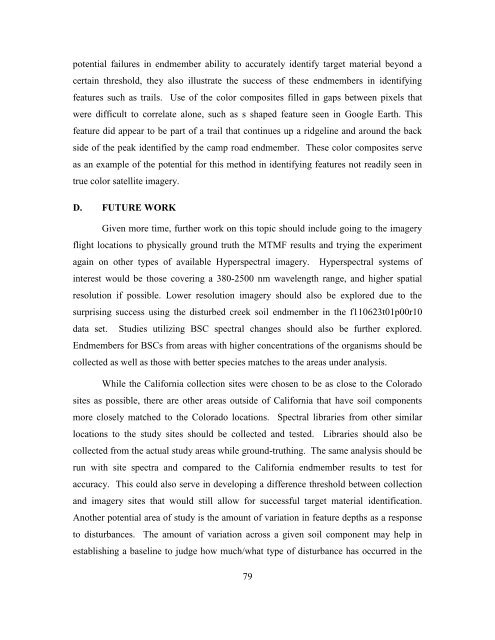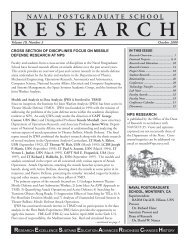Spectral Unmixing Applied to Desert Soils for the - Naval ...
Spectral Unmixing Applied to Desert Soils for the - Naval ...
Spectral Unmixing Applied to Desert Soils for the - Naval ...
You also want an ePaper? Increase the reach of your titles
YUMPU automatically turns print PDFs into web optimized ePapers that Google loves.
potential failures in endmember ability <strong>to</strong> accurately identify target material beyond a<br />
certain threshold, <strong>the</strong>y also illustrate <strong>the</strong> success of <strong>the</strong>se endmembers in identifying<br />
features such as trails. Use of <strong>the</strong> color composites filled in gaps between pixels that<br />
were difficult <strong>to</strong> correlate alone, such as s shaped feature seen in Google Earth. This<br />
feature did appear <strong>to</strong> be part of a trail that continues up a ridgeline and around <strong>the</strong> back<br />
side of <strong>the</strong> peak identified by <strong>the</strong> camp road endmember. These color composites serve<br />
as an example of <strong>the</strong> potential <strong>for</strong> this method in identifying features not readily seen in<br />
true color satellite imagery.<br />
D. FUTURE WORK<br />
Given more time, fur<strong>the</strong>r work on this <strong>to</strong>pic should include going <strong>to</strong> <strong>the</strong> imagery<br />
flight locations <strong>to</strong> physically ground truth <strong>the</strong> MTMF results and trying <strong>the</strong> experiment<br />
again on o<strong>the</strong>r types of available Hyperspectral imagery. Hyperspectral systems of<br />
interest would be those covering a 380-2500 nm wavelength range, and higher spatial<br />
resolution if possible. Lower resolution imagery should also be explored due <strong>to</strong> <strong>the</strong><br />
surprising success using <strong>the</strong> disturbed creek soil endmember in <strong>the</strong> f110623t01p00r10<br />
data set. Studies utilizing BSC spectral changes should also be fur<strong>the</strong>r explored.<br />
Endmembers <strong>for</strong> BSCs from areas with higher concentrations of <strong>the</strong> organisms should be<br />
collected as well as those with better species matches <strong>to</strong> <strong>the</strong> areas under analysis.<br />
While <strong>the</strong> Cali<strong>for</strong>nia collection sites were chosen <strong>to</strong> be as close <strong>to</strong> <strong>the</strong> Colorado<br />
sites as possible, <strong>the</strong>re are o<strong>the</strong>r areas outside of Cali<strong>for</strong>nia that have soil components<br />
more closely matched <strong>to</strong> <strong>the</strong> Colorado locations. <strong>Spectral</strong> libraries from o<strong>the</strong>r similar<br />
locations <strong>to</strong> <strong>the</strong> study sites should be collected and tested. Libraries should also be<br />
collected from <strong>the</strong> actual study areas while ground-truthing. The same analysis should be<br />
run with site spectra and compared <strong>to</strong> <strong>the</strong> Cali<strong>for</strong>nia endmember results <strong>to</strong> test <strong>for</strong><br />
accuracy. This could also serve in developing a difference threshold between collection<br />
and imagery sites that would still allow <strong>for</strong> successful target material identification.<br />
Ano<strong>the</strong>r potential area of study is <strong>the</strong> amount of variation in feature depths as a response<br />
<strong>to</strong> disturbances. The amount of variation across a given soil component may help in<br />
establishing a baseline <strong>to</strong> judge how much/what type of disturbance has occurred in <strong>the</strong><br />
79
















